Thorough Description of the Mazda Demio SkyActiv
NewmodelFebruary 15,2022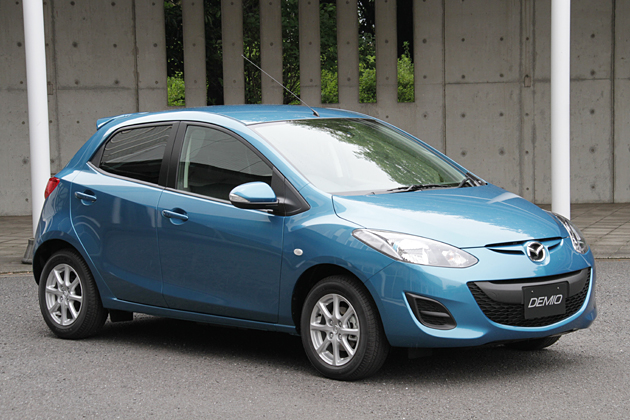
New Demio achieves hybrid-like fuel economy!
It's a fuel efficiency revolution.
The new Demio is neither a hybrid nor a small-displacement downsized turbo, but a 1.3-liter engine with idling stop system that achieves 30km/L in 10-15 mode.
The fuel efficiency of the 13-SkyActiv, which was introduced with the minor changes to the Demio, would have been unpredictable a few years ago.
Incidentally, the most fuel-efficient cars today are hybrid cars, and the Prius L, a typical example, has a 10-15 mode fuel economy of 38km/L, while the other grades have a 35.5km/L fuel economy. The Prius α has a fuel efficiency of 31km/L.
And Honda's hybrid cars, Insight and Fit Hybrid, have the same "30km/L" as the new Demio (13-SkyActiv).
In other words, the new Demio achieves the same level of fuel efficiency without the use of a hybrid system.
Incidentally, the fuel economy of idling-stop vehicles is 27km/L for the MOVE and MR Wagon minicars, 26.5km/L for the Vitz, and 26km/L for the March, all of which are higher than that of the new Demio.
The engine used is called "Skyactiv-G" and is a 1.3 liter inline four cylinder direct injection twin cam. It has a maximum output of 84 horsepower at 5400 rpm and maximum torque of 11.4 kg-m at 4000 rpm, and uses a continuously variable transmission (CVT).
The most notable feature of the Skyactiv-G engine is its high compression ratio of 14.0, which is extremely high since most gasoline engines have a compression ratio of 9.5 to 11.5, making it one of the highest in the world in the 1.3 liter class.
Moreover, this compression ratio is achieved using regular gasoline, and the car achieves a 10-15 mode fuel economy of 30km/L.
The improvement in fuel economy based on the installation of the idling stop system is about 8%, so even if the idling stop system were not installed, the car would still have the ability to achieve nearly 28km/L.
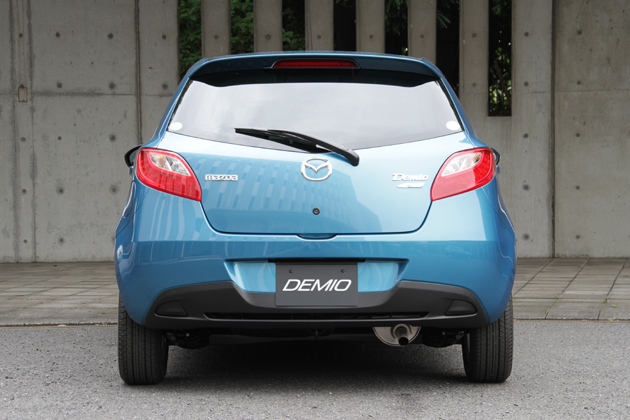
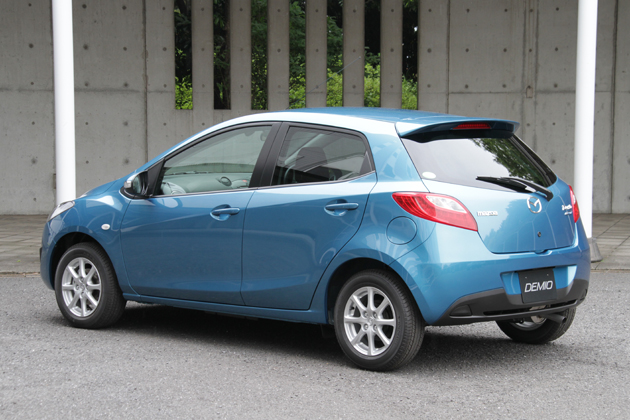
SKYACTIV-G 1.3 engine, a key technology that achieves 30.0km/L
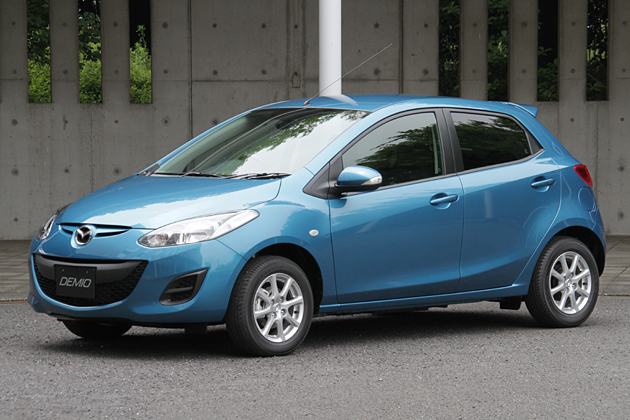
The technology behind the excellent fuel efficiency is the thorough control of combustion.
Increasing the compression ratio of the engine will improve efficiency in terms of power and fuel economy, but if the compression ratio is too high, the temperature inside the cylinder will rise. However, if the compression ratio is increased too much, the temperature inside the cylinder rises, causing knocking (spontaneous ignition) and a decrease in power output.
The 1.3-liter engine of the Skyactiv-G uses direct injection, with six multi-hole injectors (fuel injectors) that inject gasoline directly into the cylinders.
The injection method is multi-staged, and the injection can be divided into two stages. This produces a more homogeneous mixture than in conventional gasoline engines, improving combustion efficiency. At the same time, the latent heat of vaporization increases the cooling effect inside the cylinder, lowering the temperature and helping to prevent knocking.
The shape of the pistons has also been carefully designed. The higher the compression ratio, the closer the top of the piston is to the spark plug, preventing efficient combustion upon ignition. To solve this problem, a piston with a cavity at the head was adopted. This reduces the contact between the piston and the flame after ignition, and also reduces cooling loss, resulting in higher efficiency.
Cooled EGR is also adopted. A portion of the exhaust gas is cooled by the EGR cooler and recirculated to the intake air to prevent knocking. The variable valve timing system, which optimally controls the opening and closing timing of the intake and exhaust valves, has undergone further evolution. An electric S-VT is used on the intake side. When the load is high, the timing of the valve closing is accelerated to increase the intake air volume and boost torque. When the load is light, the electric S-VT works in conjunction with the exhaust S-VT to reduce the loss associated with intake and exhaust. In addition to the above, a number of other innovations have been made to reduce frictional losses in various parts of the engine, giving the impression of a trade show of environmental engine technology.
The introduction of SkyActiv is sure to inspire many other manufacturers.
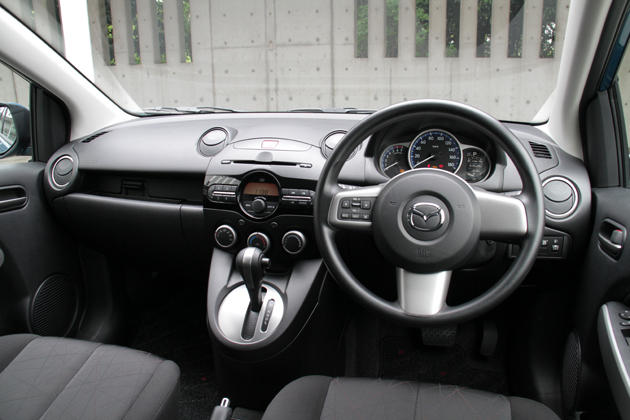
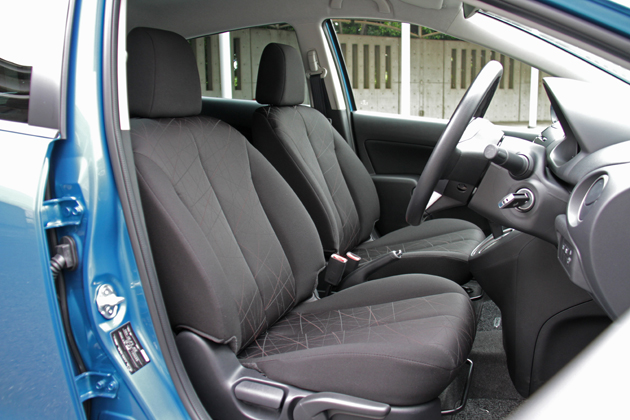
Weight reduction is also an important factor.
13-Sky Active was fitted with 14-inch aluminum wheels of a dedicated type, about 1 kg per wheel against steel wheels, and 4 wheels to reduce weight by about 4 kg. The vehicle weight will be 1,010kg.
For the front seats, the backrest cushions have been changed from S-spring to net. The front seats now have net backrest cushions instead of conventional S-spring cushions, which flexibly support the occupants' bodies and at the same time reduce the weight by about 1kg per leg. On the exterior, aerodynamic characteristics have been improved with a cover on the bottom of the body and a rear roof spoiler. As described above, weight reduction was applied not only to the engine but also to the interior and exterior.
As for safety equipment, an anti-skid system is standard. However, since it is used in conjunction with the anti-idling stop system (brake pressure increase control), it is not available on any grade except the 13-SkyActiv. It is provided as a byproduct of the idling stop system. As a function to support eco-driving, i-DM (Intelligent Drive Master) is adopted. There are three stages to help the driver feel the improvement in his or her driving.
As this is a minor change for the Demio, changes have also been made to the front mask and other design elements. The body rigidity has been improved and the shock absorber settings have been reviewed to enhance driving stability and ride comfort. In 2010, the Fit underwent a minor facelift that included the addition of a hybrid model and a review of the entire vehicle. When we think of eco-cars, electric vehicles and hybrid vehicles that use motors come to mind. Both are advanced technologies, but electric vehicles are currently difficult to own in apartment complexes.
In addition to the functions of a gasoline engine car, the motor, special battery, and control functions are essential for a hybrid. The number of parts is large. Their production and disposal processes also emit carbon dioxide. The cost is also high, and this is reflected in the price. In light of this, it is important to make steady improvements in combustion efficiency, especially for compact cars and mini cars, which are characterized by low prices.
The price of the Demio 13-SkyActiv is 1.4 million yen. Although there are differences in equipment, it is 190,000 yen cheaper than the Fit Hybrid, which has the same 10-15 mode fuel economy figures. The introduction of this car is sure to strongly stimulate many manufacturers and encourage the evolution of ecology even more than before. The Demio 13-SkyActiv is the best news for the automotive industry and car enthusiasts in a long time. The SkyActiv has the power to change the future of cars.
Buy now!TCV Corporation has the partnership with MOTA.
Copyrights ©2022 MOTA, All Rights Reserved.
Translated by TCV, MOTA liability, trademark, images and documents use rules apply for the original and the translation.
Reproduction and distribution of this article including images without written permission is prohibited.
This article was published in the past, and the grade status may differ from that of the exported / imported vehicle.
In case of Copyright infringement , a criminal investigation may be initiated to whether it's individual or a company.


